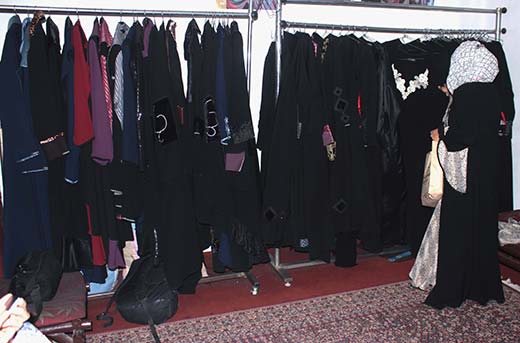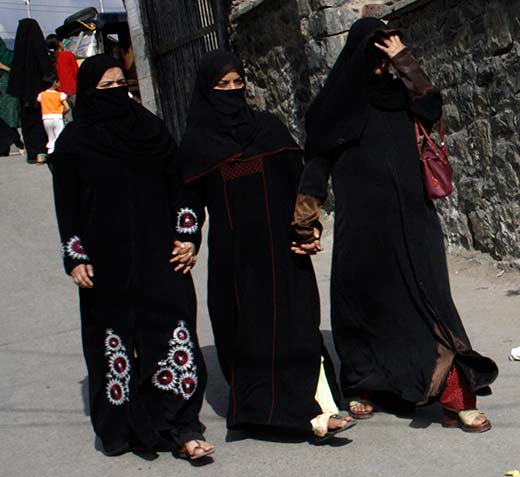Located in the busy lanes of Srinagar’s old city Mahjooba Abaya has clientele spread across continents. The designer duo sisters tell Sehar Qazi how they realised their dream of transforming traditional Abayas into a stylish and fit for all occasions garment
 ‘Men not allowed’ reads a black-and-white signboard hung outside a first floor shop in Hawal Chowk of Srinagar’s old city. It catches ones attention instantly. Near the signboard, a collage of pictures, showing girls wearing Abayas are pasted.
‘Men not allowed’ reads a black-and-white signboard hung outside a first floor shop in Hawal Chowk of Srinagar’s old city. It catches ones attention instantly. Near the signboard, a collage of pictures, showing girls wearing Abayas are pasted.
This is the place from where two sisters: Atiya Rizvi and Nafsiya Rizvi operate to create designer Abayas.
Throughout the day the shop is frequented by young girls, mostly those who are about to get married, to get customised Abayas.
Born and raised in the city of Qom in Iran, Atiya and Nafsiya came to Kashmir to turn their dreams into reality. “Some 35 years back our father shifted to Iran. He earned his living by translating Persian books into different languages,” says Atiya.
Fluent in Persian, like their father, the duo returned to Kashmir in 2003. “We can speak Kashmiri as well,” says Nafsiya.
But to start a boutique specialising in designing of Abayas in Kashmir was not as simple as it might look today. The moment sister duo pitched the idea it was looked down upon by every relative of ours. “Nobody except our husbands supported us,” said the sisters in unison. “Perhaps people couldn’t fathom the fact that girls are moving out of four walls and doing something creative,” feels Atiya. But once the boutique became famous all the criticism stopped.
“We started from a small storeroom of our house,” says Nafsiya, a talented painter and interior designer. The storeroom venture later became Mahjooba Abaya.
Atiya remembers the initial days of their venture vividly. “My sister Nafsiya was always interested in designing clothes. It was she who took the initiative.”
One day Nafsiya took a piece of charcoal and inscribed Mahjooba (A veiled women) on one of the walls of the storeroom. “That is how the brand name took birth,” says Atiya.
During the initial days of their venture only girls from the vicinity used to visit them. As Nafsiya’s designs and their unique stitching became popular, clients started to swell. “There was a sudden surge in customers. It was hard to manage from that small storeroom. And we shifted to a proper shop,” says Atiya.
But the shift from storeroom to a shop had its own costs. “We had to sell our gold to start this boutique,” says Nafsiya.
Atiya claims that her sister Nafsiya was the first one to design coloured front open Abayas. “Now it has become a fashion. Everyone is copying her designs. But our designs are unique because of the material we use.” The sisters purchase fabric imported from countries like South Korea and China. “I am happy that we are making traditional dresses like Abaya fashionable. It is back in vogue,” says Atiya.
Since its inception in 2008, the popularity of Mahjooba Abaya has grown beyond the boundaries of Kashmir region. “We have customer base across the world,” says Atiya.
There is an interesting anecdote that Atiya keenly shares about Mahjooba Abaya’s introduction in Saudi Arabia market. “One of our customers wore our designer Abaya in a party in Riyadh. Instantly people started enquiring about it. And since that day we have regular customers from that part of the world.”
Besides catering to clients in most of the Indian cities, Mahjooba Abayas are now popular in countries like Saudi Arabia, Australia, Iran and Dubai. “Girls want to have at least one Mahjooba Abaya in their wardrobe,” asserts Atiya proudly.
 Nafsiya feels that it is the goodwill and word of mouth publicity that helps a business grow, not the advertising. “If your product is good it needs no publicity. Our customers are our moving signboards.”
Nafsiya feels that it is the goodwill and word of mouth publicity that helps a business grow, not the advertising. “If your product is good it needs no publicity. Our customers are our moving signboards.”
What makes sisters proud is the moment when a girl starts covering herself just because she wants to try Mahjooba Abaya.
The sisters have divided work professionally between them. Atiya deals with the customers, taking orders, discussing details, setting delivery dates and coordinating with the 15 member strong all girls team, while Nafsiya spends most of her time in the workshop designing and stitching Abayas.
“These girls prefer to work with us even after their marriage. My sister makes it a point to pay them on time,” says Atiya.
Over the years the sisters have learnt the art of staying abreast with the changing trends in women fashion in Kashmir. They are well versed with the fashion preferences of Kashmiri women. “Kashmiri women prefer simple and decent clothes,” says Nafsiya who uses graphs and measurements she has learned in Iran.
Nafsiya makes sure that each Abaya has a distinct look and identity. That is why she minutely checks designing and stitching of every single Abaya before it is handed over to the customer. “A satisfied customer brings at least two new customers with her. That is how you grow.”
The cost of a Mahjooba Abaya ranges between Rs 2500 and Rs 3000 depending upon the fabric and design.
Nafsiya started her career as a designer by doing embroidery work for bridal wears. Later, she tried her hands at designing gowns, suits, hijabs and baby dresses. But noticing a huge demand for Abayas changed her preferences. “Even today people want the suits we used to sell earlier. But our focus is on Abayas now,” says Nafsiya.
Nafsiya says she wants to design an Islamic dress that women can wear at all occasions including marriage ceremonies. “My dream is to make a dress that will cover women fully yet will look beautiful.”
Their passion led them to develop the traditional Abaya into elegant, beautiful and comfortable garment that a modern woman can wear with style and grace. “I believe creativity is innate and can’t be taught in any school or college,” says Nafsiya.
The sisters feel that women in Kashmir should try hard to turn their dreams in to reality. “Women in Iran are quite active in public life. Kashmiri women should not let circumstances dictate their lives. They are the mothers of their nation.”














